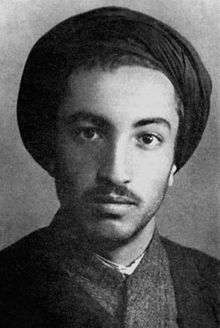Navvab Safavi

Sayyid Navvab Safavi (born Mojtaba Mir-Lowhi) (1923 – 1955) was a cleric responsible for founding of the Fada'iyan-e Islam group and with them the assassination of several leading Iranians, primarily politicians who supported the government of the Shah.
Early life
Born in Ghaniabad, Tehran into a well-known religious family in 1923,[1] He received his primary education in Tehran and left school after eighth grade when his father died.[1] Later, Safavi studied in Najaf, Iraq and worked in Abadan's petroleum installations in Khuzestan Province for a while. He is said to have been known for his striking looks and his "mesmerizing" speaking ability.[2] He later changed his name to Navvab Safavi to identify with the Twelver Shi'i Safavid dynasty.[1] His new name means "Deputies of the Safavids".[1]
Career
Safavi founded the Fada'iyan-e Islam organization in 1945,[1] and began recruiting like-minded individuals. Like the Muslim Brotherhood, Navvab Safavi believed that Islamic society needed to be purified. To do this he organized carefully planned assassinations to rid Islam of "corrupting individuals," often prime ministers of Iran's government.
Amir Taheri claims that Safavi was "the man who introduced Ayatollah Khomeini to the Muslim Brotherhood and their ideas," who "spent long hours together" with Khomeini in discussion, and visited him in Qom on a number of occasions during 1943 and 1944.[3] However, this is contradicted by the fact that the Muslim Brotherhood is a fundamentalist Sunni organisation that is against Shi'a Islam and considers it to be a heresy.[4]
He and his organization were responsible for the assassinations, or attempted assassinations of politicians Abdolhossein Hazhir, Hossein Ala' (he survived the attempt), Prime Minister Haj Ali Razmara,[5] and historian Ahmad Kasravi,[5]
Safavi and his group were closely associated with Abol-Ghasem Kashani and supported but were not members of Mohammad Mosaddegh's National Front. Safavi worked with Kashani, helping organize bazaar strikes against Premier Ahmad Qavam, public meetings in support of Palestinian Arabs, and a violent demonstration in 1948 against Premier Abdolhossein Hazhir.[6] When the Shah appointed National Front leader Mohammed Mossadegh to the post of prime minister, Safavi expected his objectives would be furthered. He demanded the government drive the British out, and that it release "with honor and respect" the assassin of Razmara. When that didn't happen, Safavi announced "We have broken away irrevocably from Kashani's National Front. They promised to set up an Islamic country according to the precepts of the Koran. Instead they have imprisoned our brothers." He later warned, "There are others who must be pushed down the incline to hell."
However relations between Kashani and Safavi, not to mention Mosaddegh, became "strained." On May 10, 1951, Navvab Safavi declared, "I invite Musadizz, other members of the National Front and Ayatollah Kashani, to an ethical trial.'[7]
Arrest and execution
Prime Minister Mosaddeq, who was preoccupied with the nationalization of the oil industry, found these activities "disruptive." On 8 June 1951 he ordered the arrest of Safavi, who stayed there until his release in February 1953. Six months later Mosaddeq was overthrown in a coup d'état. Like Kashani, Safavi supported the coup against Mosaddeq and "in the years immediately following the coup Navvab Safavi enjoyed a close association with the court and the government of Prime Minister General Fazlollah Zahedi." By 1955 it became clear the regime would not be instituting strict enforcement of Shariah law and Islamization of Iran, and was instead becoming more pro-Western. On 22 November, after an unsuccessful attempt to assassinate Hosein Ala', Navvab Safavi and some of his followers were arrested. Following a summary trial Safavi and three other members of Fada'iyan-e Islam were executed on 25 December. The clerical establishment did not attempt to intervene on their behalf.[7]
See also
References
| Wikimedia Commons has media related to Mojtaba Mir-Lowhi. |
- 1 2 3 4 5 Said Amir Arjomand (1984). From Nationalism to Revolutionary Islam. SUNY Press. p. 158. ISBN 978-0-7914-9524-7. Retrieved 13 February 2013.
- ↑ Taheri, Amir (1986). The Spirit of Allah: Khomeini and the Islamic revolution. Adler & Adler. ISBN 978-0-917561-04-7., p. 98
- ↑ Taheri, The Spirit of Allah (1985), p. 98, 102.
- ↑ Egypt’s Shiite Minority: Between the Egyptian Hammer and the Iranian Anvil from the Jerusalem Center for Public Affairs
- 1 2 Ostovar, Afshon P. (2009). "Guardians of the Islamic Revolution Ideology, Politics, and the Development of Military Power in Iran (1979–2009)" (PhD Thesis). University of Michigan. Retrieved 26 July 2013.
- ↑ Ervand Abrahamian, Iran between Two Revolutions (Princeton University Press, 1982), pp. 258-9.
- 1 2 Islamic Utopia in Pre-Revolutionary Iran: Navvab Safavi and the Fada'ian-e Eskam, Sohrab Behdad Middle Eastern Studies, January 1997
- 'Alí Rizā Awsatí (عليرضا اوسطى), Iran in the Past Three Centuries (Irān dar Se Qarn-e Goz̲ashteh - ايران در سه قرن گذشته), Volumes 1 and 2 (Paktāb Publishing - انتشارات پاکتاب, Tehran, Iran, 2003). ISBN 964-93406-6-1 (Vol. 1), ISBN 964-93406-5-3 (Vol. 2).
- Mazandi, Yousof (United Press Iranian correspondent) and Edwin Muller, Government by Assassination, Reader's Digest, September 1951.
- Taheri, Amir. The Spirit of Allah Khomeini and the Islamic revolution, Bethesda, Maryland : Adler & Adler, c1985
External links
- Bio According to RajaNews (dead link)
- Greatscholars News (About Navab Safvi)